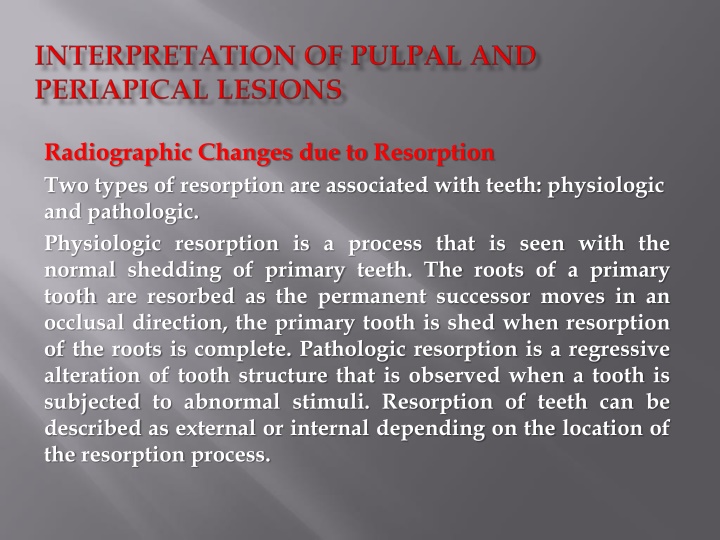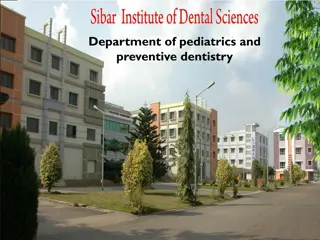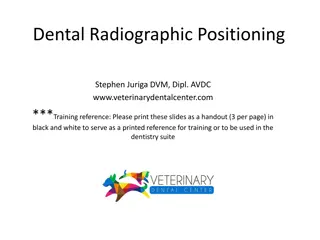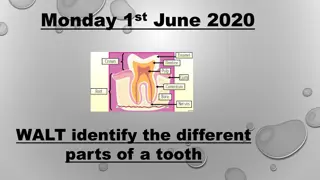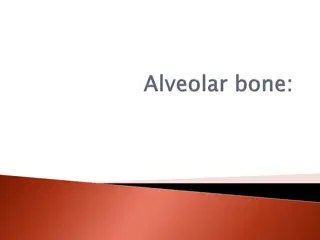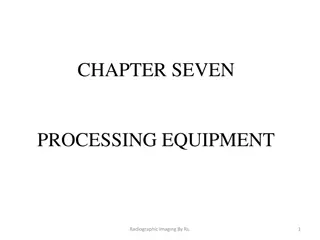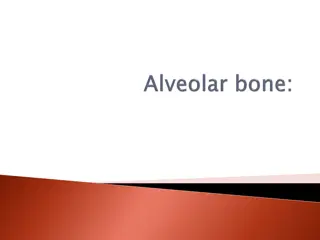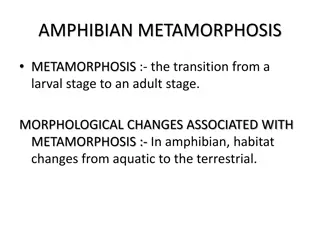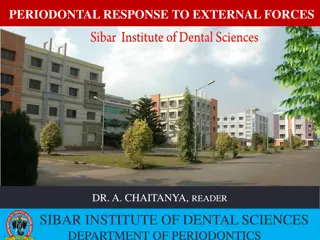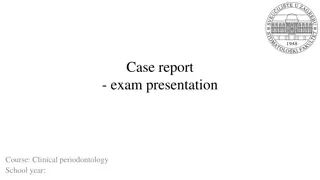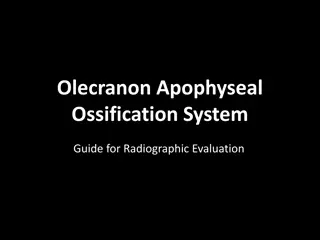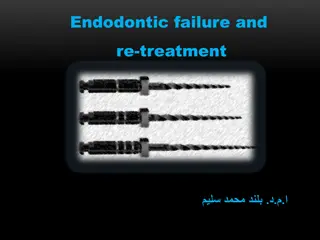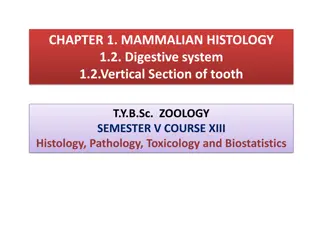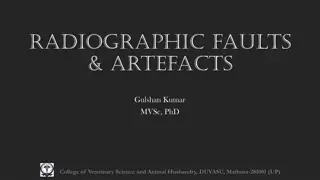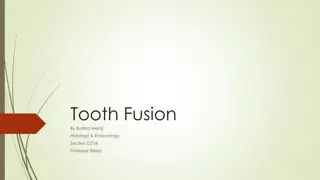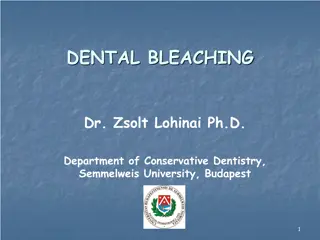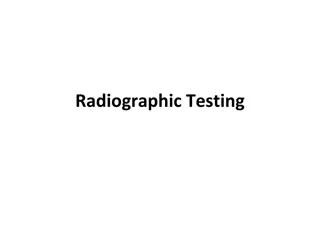Radiographic Changes Due to Tooth Resorption
Tooth resorption can be classified into physiologic and pathologic types, with external and internal resorption processes affecting teeth differently. Physiologic resorption is natural during primary teeth shedding, while pathologic resorption is triggered by abnormal stimuli. External resorption occurs along the root surface due to various factors, while internal resorption affects the crown or root internally. Dental radiographs play a crucial role in diagnosing these resorptive conditions and determining appropriate treatments. Pulpal changes such as sclerosis and obliteration can also be identified through dental imaging.
Download Presentation

Please find below an Image/Link to download the presentation.
The content on the website is provided AS IS for your information and personal use only. It may not be sold, licensed, or shared on other websites without obtaining consent from the author.If you encounter any issues during the download, it is possible that the publisher has removed the file from their server.
You are allowed to download the files provided on this website for personal or commercial use, subject to the condition that they are used lawfully. All files are the property of their respective owners.
The content on the website is provided AS IS for your information and personal use only. It may not be sold, licensed, or shared on other websites without obtaining consent from the author.
E N D
Presentation Transcript
Radiographic Changes due to Resorption Two types of resorption are associated with teeth: physiologic and pathologic. Physiologic resorption is a process that is seen with the normal shedding of primary teeth. The roots of a primary tooth are resorbed as the permanent successor moves in an occlusal direction, the primary tooth is shed when resorption of the roots is complete. Pathologic resorption is a regressive alteration of tooth structure that is observed when a tooth is subjected to abnormal stimuli. Resorption of teeth can be described as external or internal depending on the location of the resorption process.
External resorption is seen along the periphery of the root surface and is often associated with reimplanted teeth, abnormal mechanical forces, trauma, chronic inflammation, tumors and cysts, impacted teeth, or idiopathic causes. External resorption most often affects the apices of teeth, the apical region appears blunted, and the length of the root appears shorter than normal. Both the lamina dura and bone around the blunted apex appear normal. External resorption is not associated with any signs or symptoms and is not detected clinically. Teeth that undergo external resorption do not exhibit mobility. There is no effective treatment for external resorption.
Internal resorption occurs within the crown or root of a tooth and involves the pulp chamber, pulp canals, and surrounding dentin. Precipitating factors such as trauma, pulp capping, and pulp polyps are believed to stimulate the internal resorption process. Internal resorption appears as a round-to-ovoid radiolucency in the midcrown or midroot portion of a tooth. Internal resorption is generally asymptomatic. Treatment is variable, endodontic therapy may be used if the resorptive process has not physically weakened the tooth. If the tooth is weakened by the resorptive recommended. process, extraction is
In many dental procedures, information about the size and location of the pulp cavity must be obtained before treatment. Without dental radiographs, examination of the pulp chambers and canals is impossible. Pulpal sclerosis, pulpal obliteration, and pulp stones are common conditions of the pulp cavity that can be seen on dental radiographs. Pulpal Sclerosis Pulpal sclerosis is a diffuse calcification of the pulp chamber and pulp canals of teeth that result in a pulp cavity or decreased size. For unknown reasons, pulpal sclerosis is associated with aging. Pulpal sclerosis appease as a pulp cavity that is reduced in size. No clinical features are associated with pulpal sclerosis. Pulpal sclerosis is generally considered an incidental radiographic finding that is of little clinical significance unless endodontic therapy is indicated.
Some conditions (e.g., attrition, abrasion, caries, dental restorations, trauma, and abnormal mechanical forces) may act as irritants to the pulp and stimulate the production of secondary dentin, which results in obliteration of the pulp cavity. On a dental radiograph, a tooth with pulpal obliteration does not appear to have a pulp chamber or pulp canals. Teeth that exhibit pulpal obliteration are nonvital and do not require treatment. Pulp Stones Pulp stones are calcifications that are found in the pulp chamber or pulp canals of teeth. The cause of pulp stones is unknown. On a dental radiograph, pulp stones appear as round, ovoid, or cylindrical radiopacities, some pulp stones may conform to the shape of the pulp chamber or canal. Pulp stones may vary in shape, size, and number. Pulp stones do not cause symptoms and do not require treatment.
Radiographic Features of Periapical Lesions A periapical lesion is a lesion that is located around the apex (tip of the root) of a tooth. The use of dental radiographs is particularly important in the problems. Periapical lesions cannot be evaluated on a clinical basis alone. On dental radiographs periapical lesions may appear either radiolucent (dark or black) or radiopaque (light or white). identification of periapical Periapical Radiolucencies Periapical granulomas, periapical radiolucencies radiographs. These lesions cannot be diagnosed by their radiographic appearances alone, instead, diagnosis is based on the clinical features and radiographic appearances. Because it is impossible to distinguish between these three periapical lesions based on their radiographic appearance, the dental radiographer should refer to these lesions simply as periapical radiolucencies. cysts, and abscesses be are common dental that can seen on and microscopic
A periapical granuloma is a localized mass of chronically inflamed granulation tissue at the apex of a nonvital tooth. The periapical granuloma results from pulpal death and necrosis and is the most common sequela of pulpitis (inflammation of the pulp). A periapical granuloma may give rise to a periapical cyst or periapical abscess. A tooth with a periapical granuloma is typically asymptomatic but has a previous history of prolonged sensitivity to heat or cold. Treatment for a periapical granuloma may include endodontic therapy or removal of the tooth along with curettage of the apical region. On a dental radiograph a periapical granuloma is initially seen as a widened periodontal ligament space at the root apex. With time, the widened periodontal ligament space enlarges and appears as a round or ovoid radiolucency. The lamina dura is not visible between the root apex and the apical lesion.
A periapical cyst (also known as a radicular cyst) is a lesion that develops over a prolonged period of time, cystic degeneration takes place within a periapical granuloma and results in a periapical cyst. The periapical cyst results from pulpal death and necrosis. Periapical cysts are the most common of all tooth-related cysts and comprise 50 to 70% of all cysts in the oral region. Periapical cysts are typically asymptomatic. Treatment may include endodontic therapy or extraction of the tooth as well as curettage of the apical region. On a dental radiograph the typical periapical cyst appears as a round or ovoid radiolucency.
The periapical abscess is a localized collection of pus in the periapical region of a tooth that results from pulpal death. Periapical abscesses may be acute or chronic. An acute periapical abscess has features of an acute pus- producing process and inflammation. An acute abscess may result from an acute inflammation of the pulp or an area of chronic infection, such as a periapical granuloma. A chronic periapical abscess has features of a long- standing, low-grade, pus-producing process. A chronic abscess may develop from an acute abscess or a periapical granuloma. An acute periapical abscess is painful; the pain may be intense, throbbing, and constant. The tooth is nonvital and is sensitive to pressure, percussion, and heat. Chronic periapical abscesses are usually asymptomatic because the pus drains through bone or the periodontal ligament space. Clinically, a gumboil may be seen in the apical region of the tooth at the site of drainage. Treatment of the periapical abscess includes drainage and endodontic therapy or extraction. With an acute periapical abscess, no radiographic change may be evident. Early radiographic changes include periodontal ligament space. A chronic periapical abscess appears as a round or ovoid apical radiolucency with poorly defined margins. The lamina dura cannot be seen between the root apex and the radiolucent lesion. an increased widening of the
Condensing osteitis, sclerotic bone, and hypercementosis are a few of the common periapical radiopacities that can be seen on dental radiographs. Unlike periapical radiolucencies, periapical radiopacities can be diagnosed based on their radiographic appearance, clinical information, and patient history. Condensing Osteitis Condensing osteitis (also known as chronic focal sclerosing osteomyelitis (inflammation of radiopacity that is seen below the apex of a nonvital tooth with a history of long-standing pulpitis. The opacity represents a proliferation of periapical bone that is a result of a low-grade inflammation or mild irritation. stimulates condensing osteitis occurs in response to pulpal necrosis. Condensing osteitis may vary in size and shape and does not appear to be attached to the tooth root. bone) is a well-defined The inflammation that
Condensing osteitis is the most common periapical radiopacity observed in adults. The tooth most frequently involved is the mandibular first molar. Teeth associated with condensing osteitis are nonvital and typically have a large carious lesion or large restoration. Because condensing osteitis is believed to represent a physiologic reaction of bone to inflammation, no treatment is necessary. If chronic osteomyelitis is suspected from the clinical examination, in addition to a complete series of plain films, CT is the imaging method of choice. CT, with the ability to demonstrate sequestra and periosteal new bone, is important for a correct diagnosis and allows accurate staging of the disease, which is important for future assessment of healing.
Sclerotic bone (also known as osteosclerosis or idiopathic periapical osteosclerosis) is a well-defined radiopacity that is seen below the apices of vital, noncarious teeth. The cause of sclerotic bone is unknown, however, it is not believed to be associated with inflammation. The lesion is not attached to a tooth and varies in size and shape. The margins may appear smooth or irregular and diffuse. The borders are continuous with adjacent normal bone, and no radiolucent outline is seen. Sclerotic bone is asymptomatic and is usually discovered during routine radiographic examination.
Hypercementosis is the excess deposition of cementum on root surfaces. Hypercementosis results inflammation, or trauma, sometimes there is no obvious cause. On dental radiographs hypercementosis is visible as an excess amount of cementum along all or part of a root surface. The apical area is most often affected and appears enlarged and bulbous. Root areas affected by hypercementosis are separated from periapical bone by a normal appearing periodontal ligament space, the surrounding lamina dura appears normal as well. No signs or symptoms are associated with hypercementosis, most cases are discovered during routine radiographic examination. Teeth affected by hypercementosis are vital and do not require treatment. from supraeruption,
